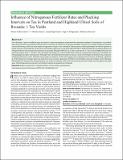Influence of Nitrogenous Fertilizer Rates and Plucking Intervals on Tea in Peatland and Highland Ultisol Soils of Rwanda: 1 Tea Yields

View/
Publication Date
2020Author
Wilson Dufitumukiza, P Okinda Owuor, Joseph Bigirimana, Ange R Akingeneye, Balthazar Murenzi
Metadata
Show full item recordAbstract/
Tea in Rwanda, is grown in different agro-ecosystems comprising highlands and drained low elevation peatlands. The plantations use uniform
agricultural practices imported from Eastern Africa countries, but without re-testing for suitability. The practices include nitrogenous fertilizer
use and harvesting, which are most expensive agronomic inputs in tea cultivation. These practices need optimization for tea the growers to
realise maximum tea production. Trials were conducted for eight years using clone TRFK 6/8 fields in Kitabi and Mulindi to evaluate influence of
nitrogen fertiliser rates and plucking intervals on tea yields. Nitrogen (NPKS 25:5:5:3) rates used were 0, 75, 150, 225 and 300kg N/ha/year and
plucking intervals were 7, 14 and 21 days. Tea yields were higher (p ≤ 0.05) in Kitabi than in Mulindi, implying tea productivity in Rwanda vary
with geographical region of production. Although mean site yields demonstrated increase (p ≤0.05) with nitrogenous fertiliser rates, responses
varied between the two sites. At Kitabi, annual yields increased (p ≤0.05) with nitrogen rates, peaking at 225 N ha/year. At Mulindi, significant
(p ≤0.05) response to nitrogen rates was observed in only one year. Application of fertiliser was therefore necessary in Kitabi, while in Mulindi,
little benefit was realised from nitrogen fertiliser use. Yields increased (p ≤0.05) with short plucking intervals at both sites throughout the eight
years. Shortening plucking intervals can therefore improve tea production in Rwanda.
Collections
- Department of Chemistry [339]
